Germany Office Real Estate Market Size
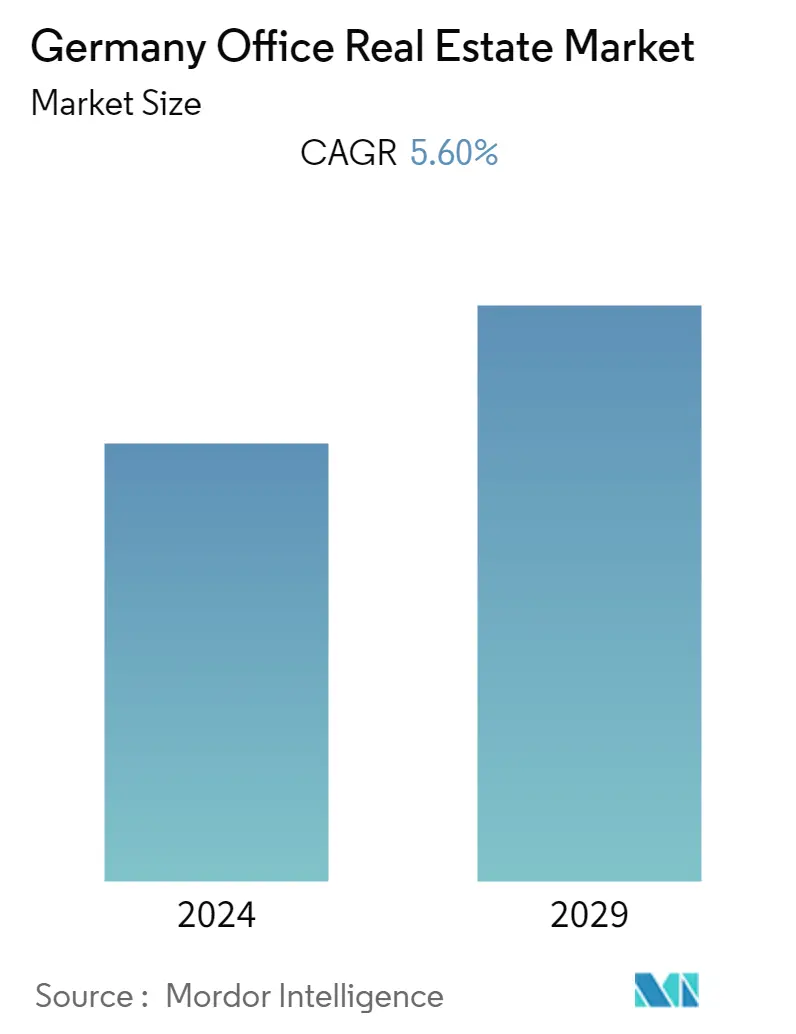
| Study Period | 2020 - 2029 |
| Base Year For Estimation | 2023 |
| Forecast Data Period | 2024 - 2029 |
| Historical Data Period | 2020 - 2022 |
| CAGR | 5.60 % |
| Market Concentration | Medium |
Major Players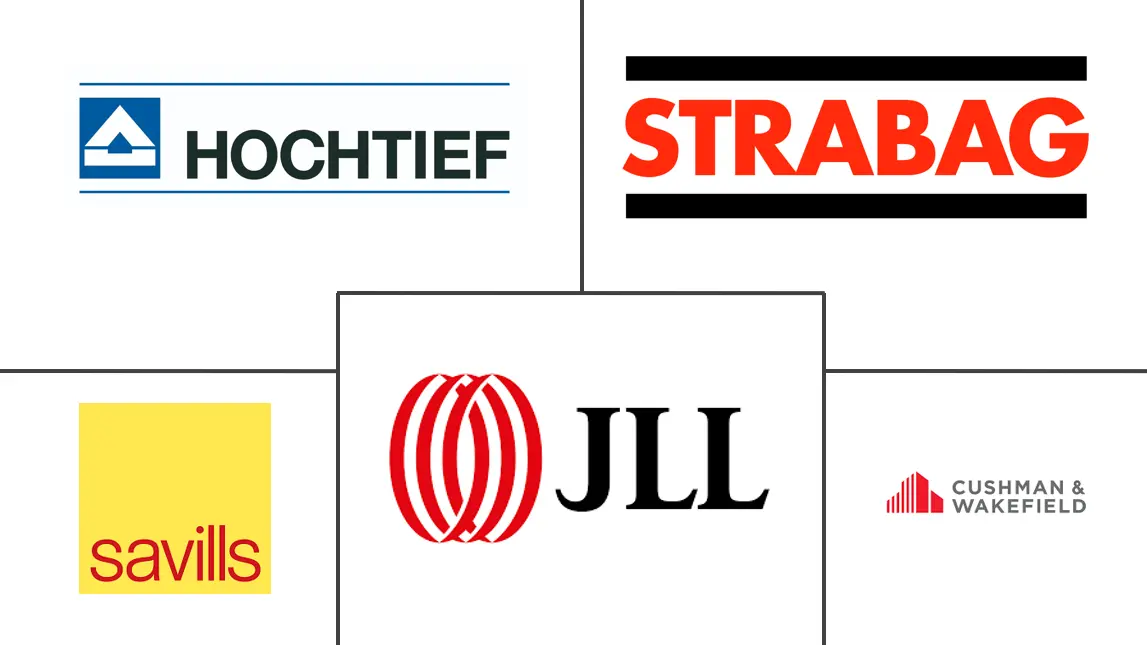
*Disclaimer: Major Players sorted in no particular order |
Germany Office Real Estate Market Analysis
- The German office real estate market is expected to record a CAGR of over 5.6% during the forecast period, 2022-2027. Due to restrictions, social distancing policies, and a work-from-home culture, the COVID-19 pandemic significantly impacted Germany's office real estate market, working habits, and locations. Due to the pandemic, the majority of businesses have implemented remote working. Exogenous shocks like the conflict in Ukraine, soaring inflation, and supply constraints are stifling the German economy. These factors have made economic activity considerably less than anticipated at the start of the year.
- However, the office market fared well in the third quarter of 2022 due to a balance between uncertainty and strong fundamentals. The big cities took up slightly under 2.8 million sq. m of office space in the first nine months of 2022, a 29% rise from the same period in 2021. This is where the current problem does seem a little different, especially given the rise in take-up in all of the Big 7 office strongholds. In Düsseldorf, it's just under 7%, but in Stuttgart, it's 200%.
- As the market for new-build space is still very competitive, making it difficult to pre-let space, and because there is growing pressure to get rid of outdated premises, many occupiers, particularly larger corporates, are currently moving forward with planned moves and new leases by up to two years.
- Most businesses are looking for office space with excellent standards to recruit and keep employees. An appealing workplace environment increasingly influences a company's business performance. About 43% of businesses intend to increase investment in a sustainable and flexible workplace between now and 2025, according to a recent JLL survey.
- Trends also suggest that much larger sums of money must be spent in existing stock to meet market demand and account for a drop in new construction activity, which can be profitable because most businesses are still prepared to pay a higher rental rate for a property that has been renovated sustainably and complies with ESG standards. Estimates indicate that by 2030, over one-fifth of all German office space will no longer adhere to European ESG requirements, demonstrating the urgent necessity for proactive solutions.
- Companies looking for office space have a total of roughly 4.6 million sq. m of short-term options in the big real estate powerhouses. However, vacancy rates will likely steadily increase, especially for lower-grade office space. The use of premium space makes up over 70% of the total office space. Unoccupied space caused by relocation that does not fit the needs of new tenants tends to stay vacant. This area can only be advertised due to large rental price reductions or after extensive renovations.
Germany Office Real Estate Market Trends
This section covers the major market trends shaping the Germany Office Real Estate Market according to our research experts:
Prime Rents Continue to Rise Due to Rental Adjustment Clauses in Leases
Indexation clauses in leases have become a matter of discussion in the current market scenario, as they allow owners to protect themselves from potential value declines.
Rental adjustment clauses are present in 90-95% of all office leases signed in the last few years. Although some of these take the form of rental escalations, most of these agreements include indexation clauses to allow for rent adjustments depending on the overall cost of living index (inflation).
Indexation clauses in leases can take a lot of different forms. The most typical mechanism for a 40% share entails raising the rent each year at the same rate as the percentage increase in the cost-of-living index, or inflation. This kind of legislation has grown more common in recent years. However, it has been noted that there has been a partial move away from indexation clauses as of this year.
Due to the significant uncertainty surrounding the direction of inflation, many tenants are finding that the risk of being unable to pay their rent in the future is becoming too big. In contrast, landlords still need to preserve value. Thus, many agreements, particularly those involving long leases, are based on rental escalation, which means that rent will climb in accordance with previously agreed-upon set rate increases. In terms of their calculations, this gives owners security while lowering the risk for tenants. Rent escalation and indexation clauses contribute to underlying rental growth when used to increase rents.
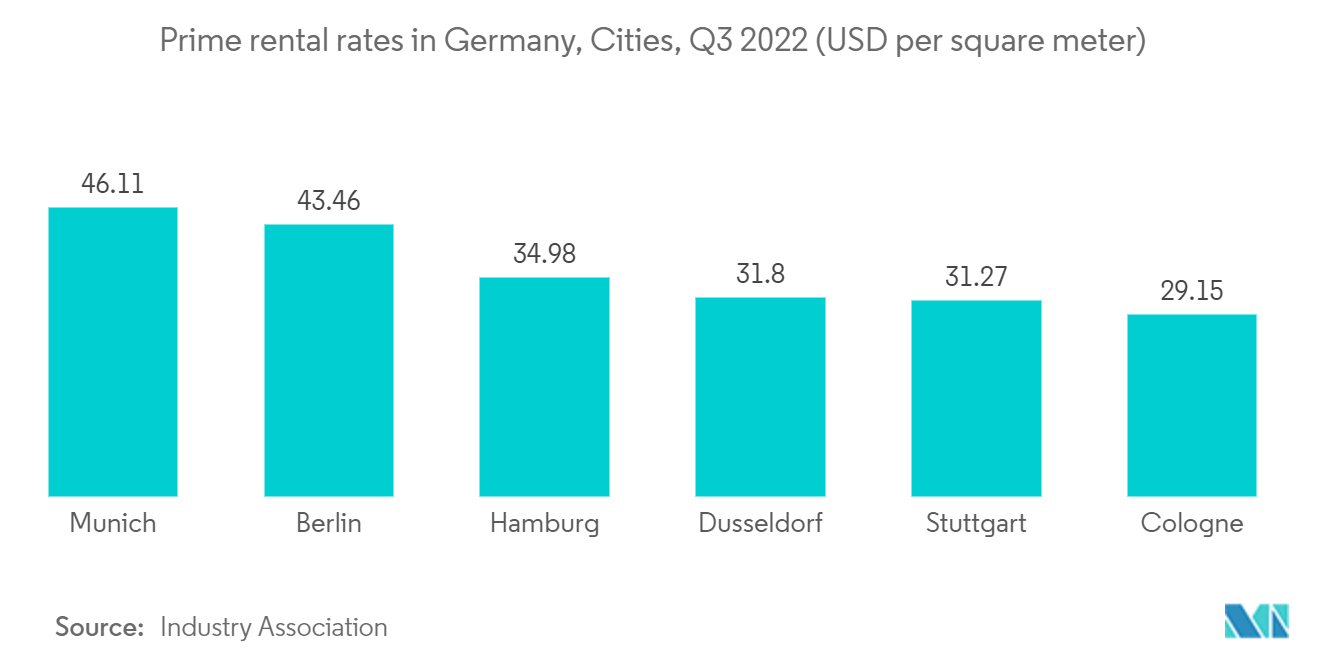
Office Market Braces Itself Against Recessive Trends
Demand is still very strong, especially for upscale space. As the market for new-build space is still very competitive, making it difficult to pre-let space, and because there is growing pressure to get rid of outdated premises, many occupiers, particularly larger corporates, are currently moving forward with planned moves and new leases by up to two years.
Most businesses are looking for office space with excellent standards to recruit and keep employees. An appealing work environment increasingly influences a company's business performance. About 43% of businesses intend to increase investment in a sustainable and flexible workplace between now and 2025.
Trends also suggest that far larger sums than in the past must be invested in existing stock due to a drop in new construction activity and to meet market demand. Most businesses are still prepared to pay a higher rental rate for space that has been sustainably renovated and complies with ESG standards.
According to estimates, by 2030, over one-fifth of Germany's total office stock will no longer comply with European ESG requirements, demonstrating the urgent need for proactive responses.
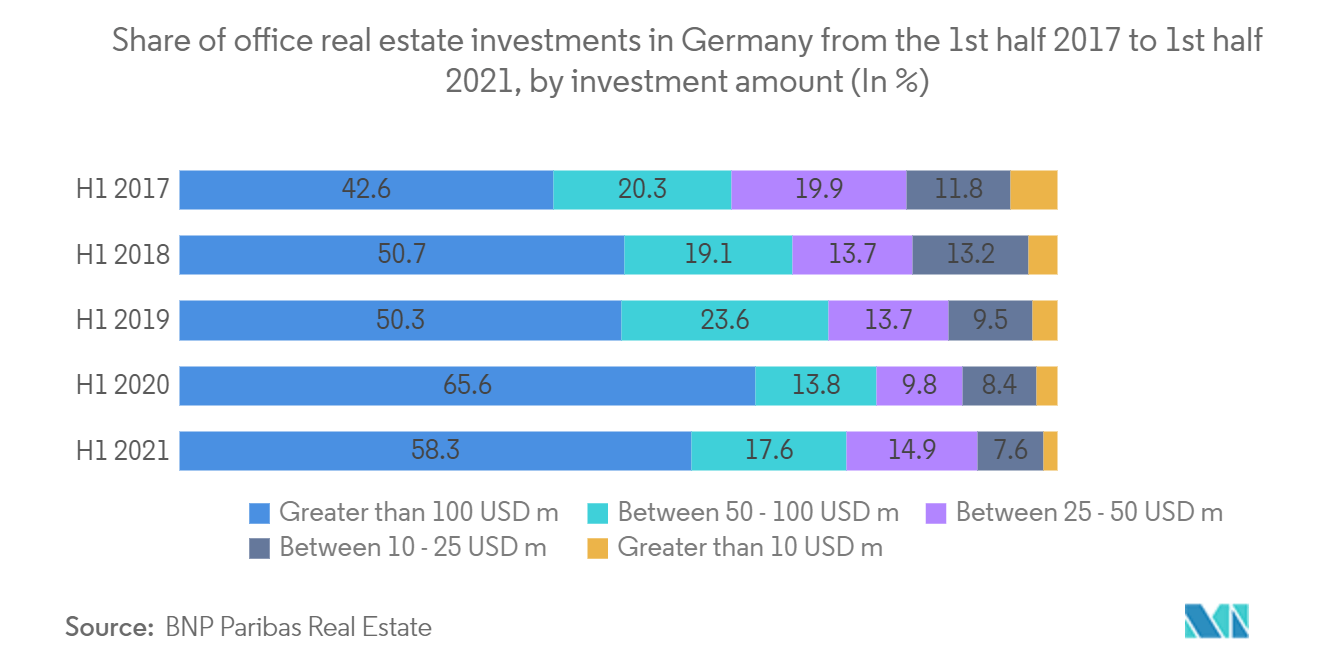
Germany Office Real Estate Industry Overview
The top players in the German real estate sector are covered in this study. The residential real estate market in Germany is extremely fragmented. Large firms have financial resources to their advantage, whereas small businesses can compete effectively by building expertise in local markets. Savills, JLL, Cushman & Wakefield, Knight Frank, etc., are some of the main players in the market.
Germany Office Real Estate Market Leaders
-
Savills
-
JLL
-
Cushman & Wakefield
-
STRABAG
-
BAUER Group
*Disclaimer: Major Players sorted in no particular order
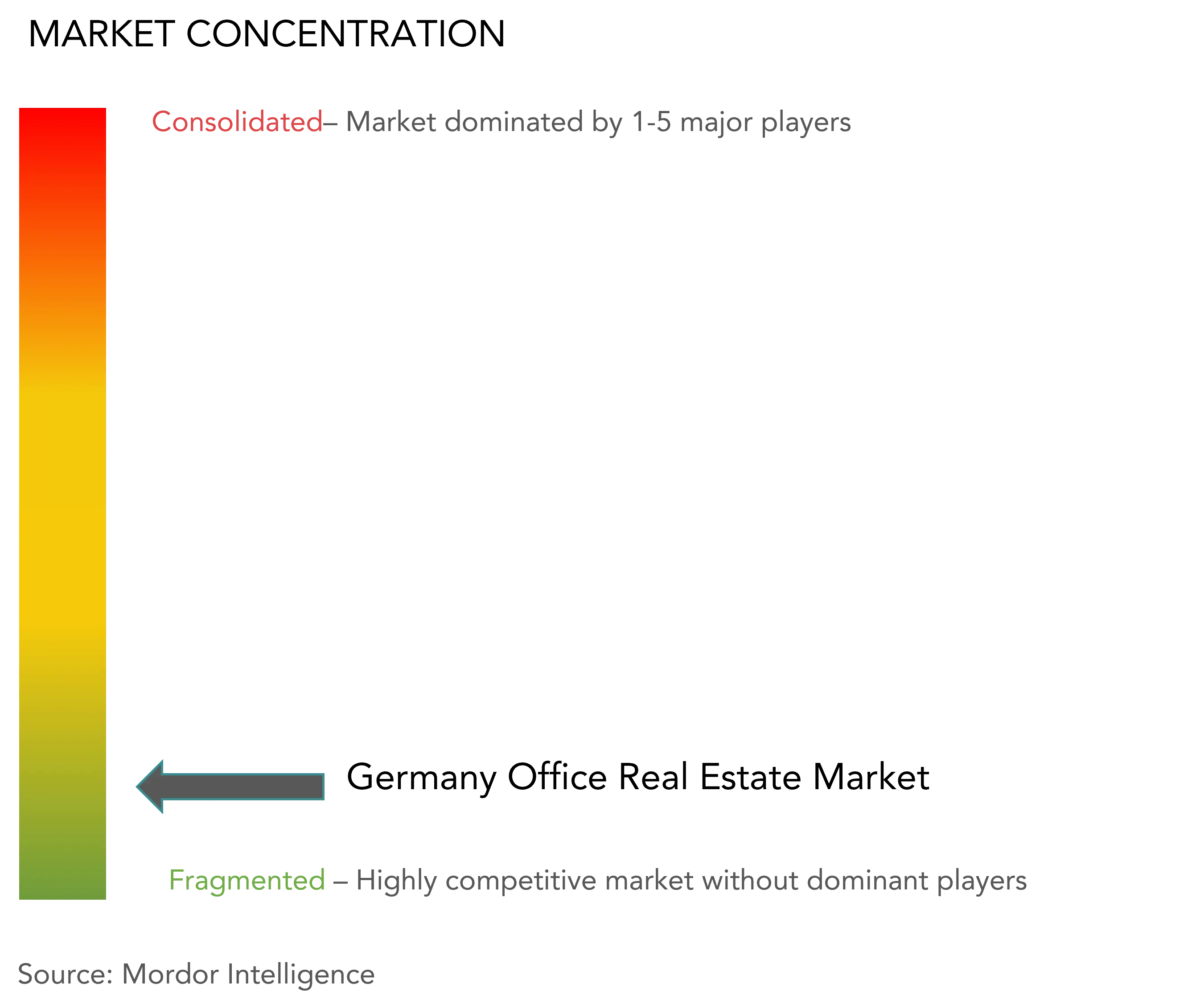
Germany Office Real Estate Market News
- November 2022: NREP, an urban investor with USD 19 billion of assets under management, announces the continued extension of its impact into Northern European countries following its first real estate investment in Germany and the establishment of a dedicated team of eight initial employees.
- June 2022: Prologis Inc., a pioneer in global logistics real estate, announced the purchase of a portfolio of 11 buildings in Germany. Buildings in Rhine-Ruhr, Berlin, Rhine-Main, Rhine-Neckar, Hannover, Ulm, and Regensburg are in target markets that assist the company's expansion strategy.
Germany Office Real Estate Market Report - Table of Contents
1. INTRODUCTION
- 1.1 Study Background
- 1.2 Study Assumptions and Market Definition
2. RESEARCH METHODOLOGY
3. EXECUTIVE SUMMARY
4. MARKET INSIGHTS AND DYNAMICS
- 4.1 Market Overview
-
4.2 Market Dynamics
- 4.2.1 Market Drivers
- 4.2.2 Market Restraints
- 4.2.3 Market Opportunities
- 4.3 Industry Attractiveness - Porter's Five Forces Analysis
- 4.4 Industry Value Chain Analysis
- 4.5 Technological Innovations in the Office Real Estate Market
- 4.6 Government Regulations and Initiatives in the Industry
- 4.7 Insights into Rental Yields in the Office Real Estate Segment
- 4.8 Insights into the Key Office Real Estate Industry Metrics (Supply, Rentals, Prices, Occupancy/Vacancy (%))
- 4.9 Insights into Office Real Estate Construction Costs
- 4.10 Insights into Office Real Estate Investment
- 4.11 Impact of the COVID-19 on the Market
5. MARKET SEGMENTATION
-
5.1 By Key Cities
- 5.1.1 Berlin
- 5.1.2 Hamburg
- 5.1.3 Munich
- 5.1.4 Cologne
- 5.1.5 Other Cities
6. COMPETITIVE LANDSCAPE
- 6.1 Market Concentration Overview
-
6.2 Company Profiles - Real Estate Players *
- 6.2.1 Savills
- 6.2.2 Cushman & Wakefield
- 6.2.3 CBRE
- 6.2.4 Knight Frank
- 6.2.5 JLL
- 6.2.6 Buero Immobilien
-
6.3 Company Profiles - Developers *
- 6.3.1 STRABAG
- 6.3.2 BAUER Group
- 6.3.3 Zech Group
- 6.3.4 Hochtief
7. FUTURE OF THE MARKET
8. APPENDIX
** Subject To AvailablityGermany Office Real Estate Industry Segmentation
Office real estate is the construction of buildings for leasing and selling purposes to companies from different sectors. This report aims to provide a detailed analysis of the office real estate market. It focuses on the market insights, dynamics, technological trends, and government initiatives.
The German Office Real Estate Market is Segmented by Key Cities (Berlin, Hamburg, Munich, Cologne, and Other Cities). The report offers market size and forecast in value (USD billion) for all the above segments.
| By Key Cities | Berlin |
| Hamburg | |
| Munich | |
| Cologne | |
| Other Cities |
Germany Office Real Estate Market Research FAQs
What is the current Germany Office Real Estate Market size?
The Germany Office Real Estate Market is projected to register a CAGR of 5.60% during the forecast period (2024-2029)
Who are the key players in Germany Office Real Estate Market?
Savills, JLL, Cushman & Wakefield, STRABAG and BAUER Group are the major companies operating in the Germany Office Real Estate Market.
What years does this Germany Office Real Estate Market cover?
The report covers the Germany Office Real Estate Market historical market size for years: 2020, 2021, 2022 and 2023. The report also forecasts the Germany Office Real Estate Market size for years: 2024, 2025, 2026, 2027, 2028 and 2029.
Germany Office Real Estate Industry Report
Statistics for the 2024 Germany Office Real Estate market share, size and revenue growth rate, created by Mordor Intelligence™ Industry Reports. Germany Office Real Estate analysis includes a market forecast outlook to 2029 and historical overview. Get a sample of this industry analysis as a free report PDF download.



